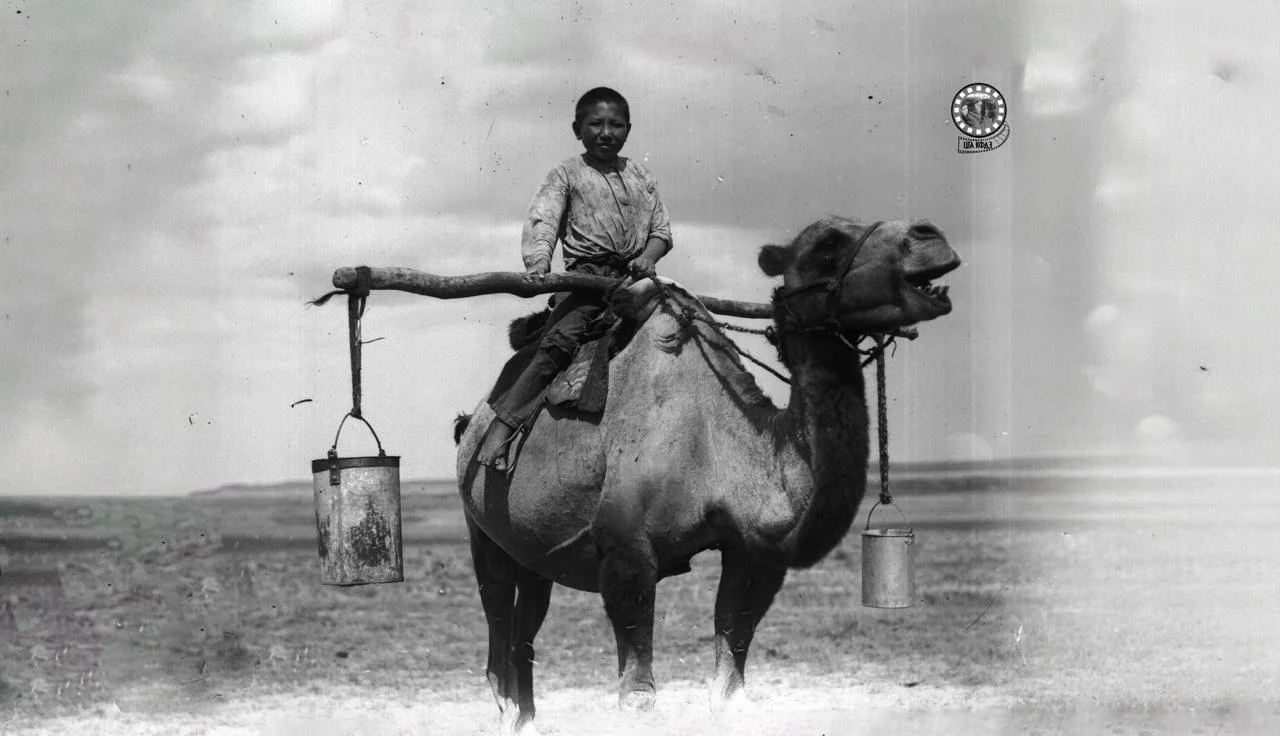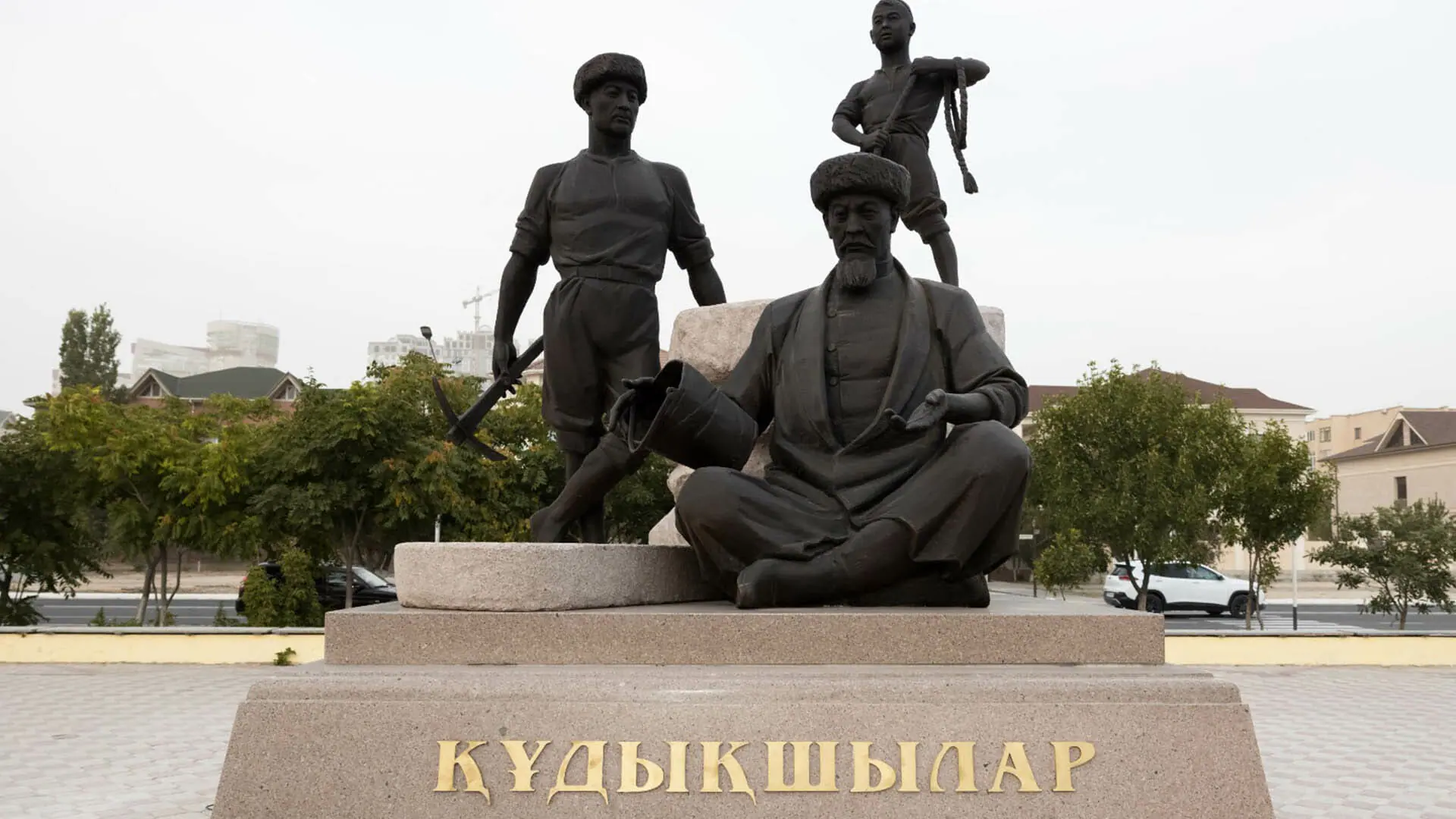The qudykshylar, or well diggers, practiced a craft of great importance to the Kazakhs. In a land where survival depended on water, they were both craftsmen and guardians of ancient knowledge, able to read the earth and uncover water where others saw only desert. In 2023, an architectural sculpture was erected in Aktau in their honor, a tribute to their role in sustaining communities in the Mangystau region, where access to drinking water has always been a challenge. In an interview for Qalam, ethnographer Tattigul Kartayeva shares insights into the unique traditions of Kazakh well digging, the remarkable skills of those who could reliably locate underground springs, and the places in Kazakhstan where this historical heritage can still be found today.
The Qudykshylar: The Saviors of the Steppe
In the arid steppes and deserts, the ability to find and use underground water sources was often a matter of life and death. The masters who possessed this skill were called qudykshy (or well digger), and they were held in great respect.
However, not everyone could become a well digger. A qudykshy was usually a strong, skilled, and quick-witted man, who often worked in groups because regardless of whether water lay close to the surface or deep underground, the work required several people. Some removed clay from the bottom of where the well was being dug, while others prepared materials to reinforce the walls. For example, in the Naryn Sandsi
A special role was given to the most experienced master, the elder, who knew all the intricacies of well digging. He directed the work and ensured that every step was in keeping with all the rules.
The well-known Polish writer and artist Bronisław Zaleski, who was exiled to the Kazakh steppe in the mid-nineteenth century, left several vivid notes on wells in his book Life of the Kazakh Steppei
In these sun-scorched steppes, where not a single road has been laid by man, where every place looks the same and wells are exceedingly rare, a mistake in choosing direction can cost a traveler days of wandering in the waterless desert.
It is utterly impossible to move about without a guide. The Kazakhs know their steppes perfectly; at night, they navigate by the stars. A foreigner, therefore, must rely on native guides, in whom he, first and foremost, sees examples of local customs. The guide’s duties include finding drinking water and pastures for horses and camels, choosing the shortest route, and supplying the traveler with provisions, which almost always consist of mutton.
How the Qudykshylar Found Water
Well diggers who had extraordinary talent and had absorbed the experience of many generations were known as qözi qaraqty, meaning ‘clear-sighted’ or ‘perceptive’ by their communities. It was believed these individuals could perceive what was hidden from others, such as the invisible vapor rising from inside the earth.
This ability was demonstrated through a wide range of ancient methods. Indeed, there were many techniques for locating underground water sources. According to one of the oldest, a qudykshy would follow a rider or a herd of horses and then lie down on the ground, pressing his ear to the earth. By listening to the hollow echo of the hoofbeats, he could determine whether water lay beneath that spot.
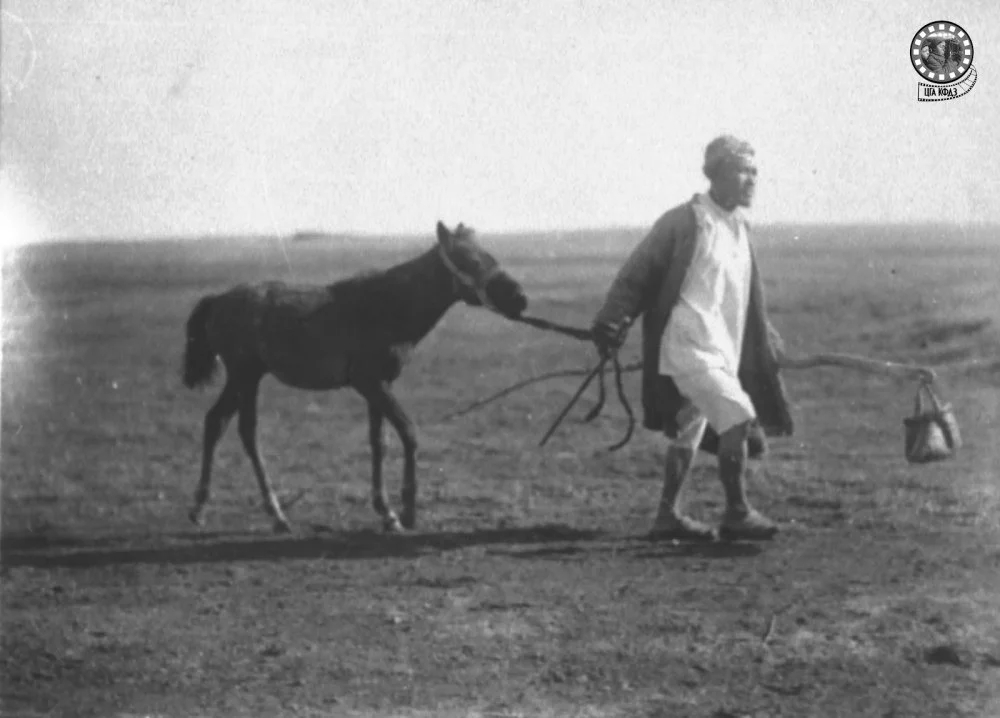
Dmitry Bagayev. Water delivery to a village in summer. Pavlodar region, 1917 / CSACPA
Experienced master well diggers could also sense the subterranean rumble of water streams flowing through underground keueks, or channels. This method was widely used in the Ustyurt Plateaui
In order to locate future shyngyrau, or deep wells, in arid areas, a very different method was applied. The masters would dig up grass roots, taste them, and rub off the soil from this vegetation between their palms to smell it. In this way, they could detect traces of moisture and even ‘catch’ the scent of an aquifer. This was considered a special gift among true well diggers.
Wells in the Kazakh Steppe: From the Bronze Age to Zhangir Khan
Archaeological research confirms that the history of well digging on the territory of modern Kazakhstan goes back to the Bronze Agei
This shows that even thousands of years ago steppe dwellers knew how to locate water and build wells that were designed to last for decades. This is also evident in the methods used to reinforce them: the walls of the wells were lined with thin saxaul rods about 4 to 5 centimeters in diameter. The gaps between them were carefully packed with grass, which both strengthened the structure and served as a natural filter.
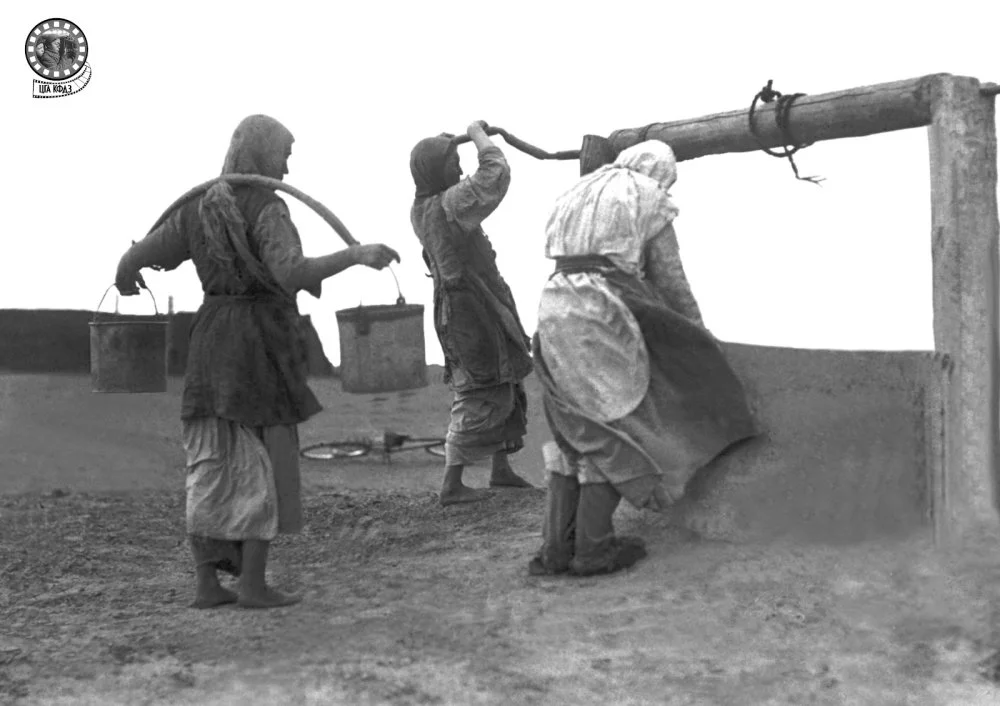
Dmitry Bagayev. Drawing water from a well. Pavlodar region, 1920 / CSACPA
It is also important to note that the climate during the Bronze Age was significantly hotter than today, which meant wells had to be deeper and wider. For example, the wells in the Shagalaly settlementi
A striking example of well-digging craftsmanship in the Kazakh steppe is the famous well at the mausoleum of Khoja Ahmed Yasawii
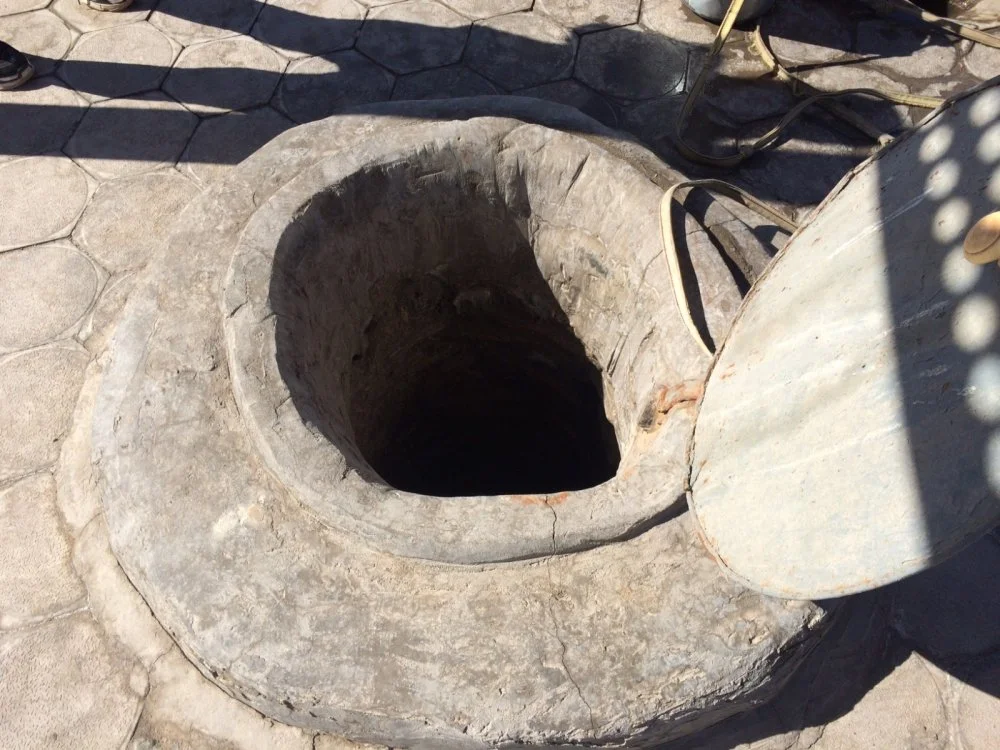
Well near Arystanbab mausoleum (copy) / Tattigul Kartaeva
The well at the Arystan Bab Mausoleumi
In the later Middle Ages, brick lining was commonly used in clay wells, reflecting the development of local ceramic traditions. Steps were also built into wells so that caretakers could descend to the bottom and clean the shaft. Between the horizontal rows of brickwork, a single brick was placed vertically, creating a kind of foothold. Such steps were typically found in wells with narrow diameters. Similar structures were also widespread among other peoples of medieval Asia.
The Kazakhs of Bukhara also used brick linings in their wells, and the diameter of the clay shafts reached between 1.20 and 1.5 meters.
Jangir Khani


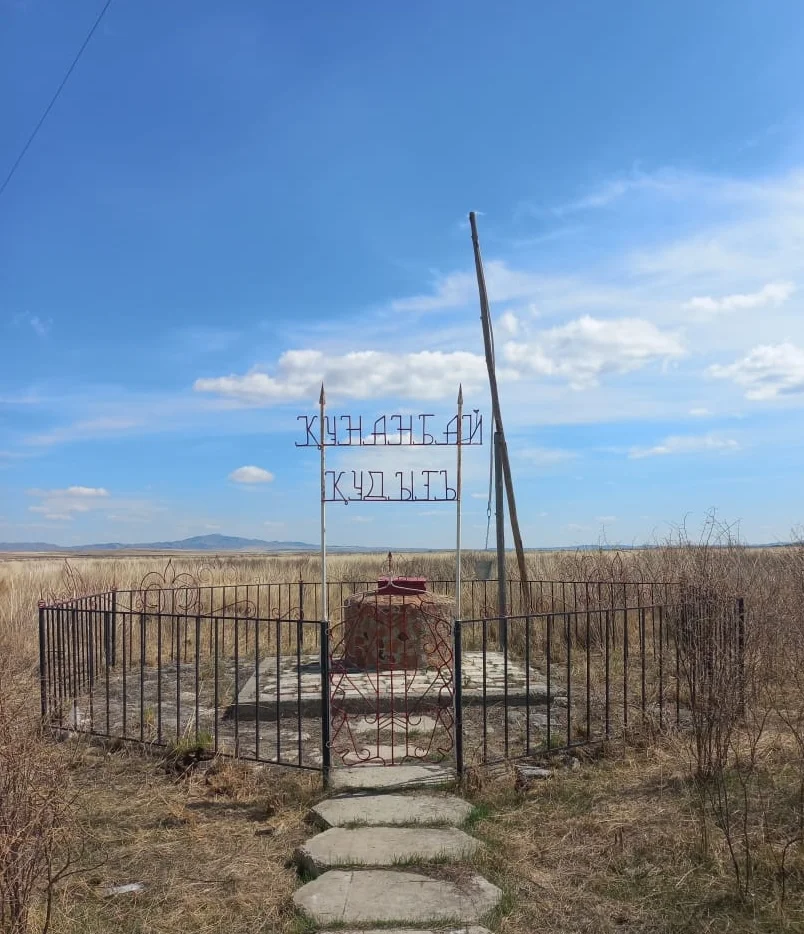
Kunanbai’s well / Tattigul Kartaeva
Another well of note is the Qunanbai well. It was built in 1840 by Abai Qunanbaiuly’si

Types of Wells and Their Characteristics
Wells were classified by purpose as either permanent or seasonal or by their method of construction as either lined or unlined. Permanent wells were usually dug along nomadic and caravan routes, as well as near settlements. Their depth often exceeded 10 meters, and thanks to reinforced walls, many remained in use for decades. The lining was typically made of stone or tightly compacted grass.
Seasonal wells were dug only at temporary encampments and used during migrations, and so they were shallow and could easily be filled in when no longer needed. These included tañqyi

A variety of materials were used to reinforce the walls, giving rise to different names: stone wells, willow wells, düzgen wells, shrub wells, saxaul wells, comb-root wells, and clay wells. Wells were also often named according to the taste of their water: aqsu (pure ‘white’ water), tushchy (fresh), alğau or alğauly (slightly salty), ashchy or ashchylau (slightly bitter), ermek (astringent), bal (‘honeyed’, soft), sütti (‘milky’, thick). A well that had run dry was called qūr qūdyq (meaning ‘dry well’).
It was a fact that regardless of its type, building a well required careful and complex construction. Even among stone wells, there were several varieties. Depending on local geological conditions, some were entirely lined with stone. Such wells are common in Mangystau, Doñyztau, northern Ustyurt, the Aral region, the Abai region in East Kazakhstan, and the Mongolian Altai. In Mangystau, the Aral, Doñyztau, and northern Ustyurt, smaller stone wells were more typical, while in southern Ustyurt, deep stone shafts were dug, or what is known as the shyngyrau.
Zaleski described the wells on Mangystau as follows:
The limestone layer that forms the surface of Mangyshlak is, in many places around the Novopetrovsk Fortressi
Legendary Well Diggers
In Kazakh culture, well diggers were always valued for their innate attentiveness and extraordinary intuition. One widely known story recounts the tale of Baibolat, a Kazakh from the Aral region, who possessed the gift of locating underground springs. During a migration north toward Arka, he noticed steam rising from the ground and ordered a well to be dug there. The water reserves proved so abundant in that spot that the well soon became known as Baibolat qudyğy, or the Baibolat spring, where travelers would stop. Interestingly, the renowned Tabyn batyr Bukarbay tried several times to dig wells near the Baibolat spring but failed—no water ever appeared there.
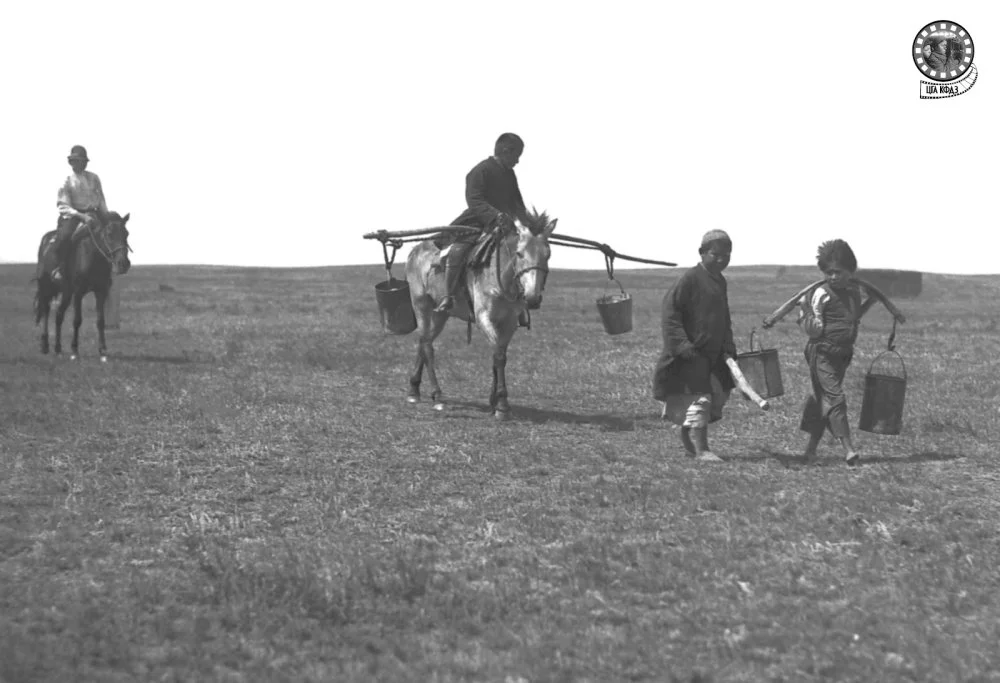
Dmitry Bagayev. Water delivery to a village in summer. Pavlodar region, 1930 / CSACPA
This reverence for master well diggers extended beyond individual feats, becoming a lasting cultural tradition honored through memorials. For example, there were two brothers called Duispai and Tamen, who lived in the Karakum Desert and were highly skilled masters at digging and lining wells in the sands. After their deaths, mausoleums were erected over their graves, and the tami
The Payment of 130 Horses for a Well
In Mangystau and Ustyurt, the name of the well digger Beineubai Qulsharuly (1864–1941) has long since been legendary. He dug and reinforced countless wells and even studied under the famous scholar-theologian Taymas-ishan of the Babyk clan. According to tradition, Beineubai was not only a strong and skilled well digger but he also possessed two special gifts: the ability to detect underground water sources and to foresee the future.
One day, a wealthy man named Jūban of the Qosai-Tinei clan invited Beineubai to dig a deep well at Qonyroi, a site near caravan routes and nomadic trails. Realizing the water lay very deep, the master agreed to dig it—on one condition. He would be paid triple his usual rate, as if for three wells. It is said that Beineubai arrived at Qonyroi with his ten-year-old son. At dawn, the boy went out and later returned saying, ‘I’ve found the place for the well.’
Beineubai had a special technique: he would gauge the depth of water by tying a stone to a horse’s tail. Using this method, he confirmed that there was indeed water at the spot his son had chosen, but it was nearly 100 meters underground. He then struck a deal with Jūban for 100 horses.
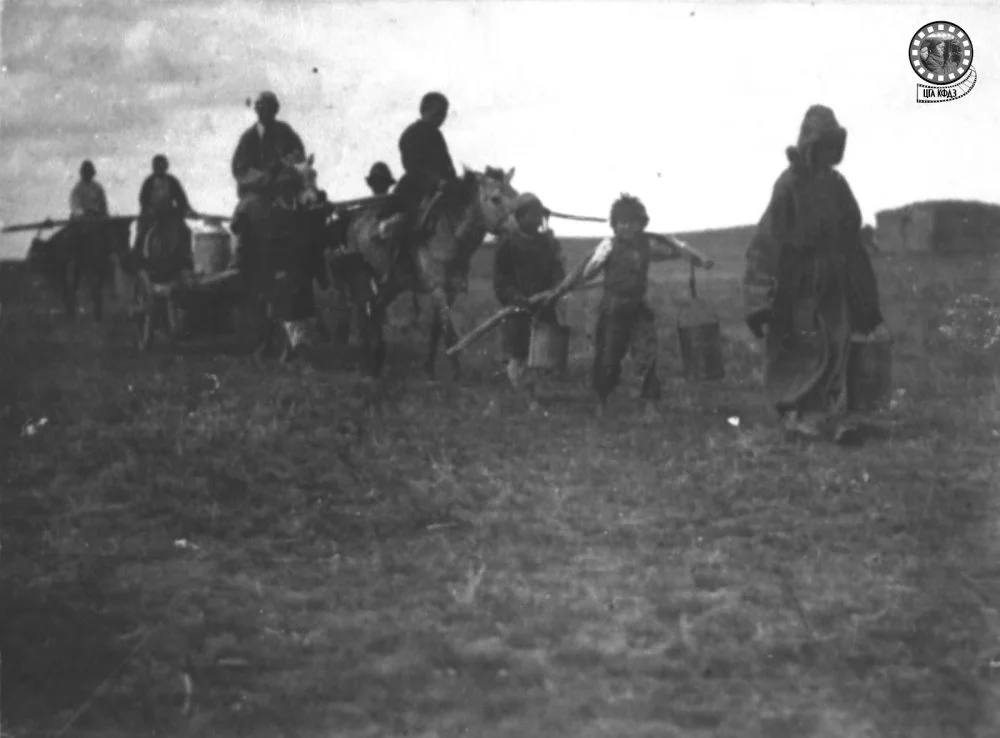
Dmitry Bagayev. Water delivery to a village in summer. Pavlodar region, 1917 / CSACPA
When the well was finished and Jūban wanted to settle accounts, Beineubai told him, ‘First drive in a few herds and water them from the well.’ A thousand horses were led to the new well, and when they had drunk their fill, the water level had not dropped even by the depth of a rope. Amazed by this, Jūban added thirty more horses to the agreed payment. Ever since, the people have called this the most expensive well ever dug—‘the one dug for 130 horses’.
But despite his fame and talent, having been educated by an ishani
Continuing the Tradition
Today, with the advances of modern technology, the need for old wells has gradually diminished. Many traditional types of wells have fallen out of use, the old shafts have long been filled in, and with the passing of the older generations, the true keepers of our oral memory, research into this subject has become even more difficult. Yet, it would be wrong to say that the art of well digging has been lost forever. In villages where livestock are still maintained, skilled masters capable of locating underground water sources are very much in demand even today.
Moreover, ancient craft traditions remain currently useful as well. For example, in the village of Khan Ordasy in western Kazakhstan, people still line well shafts with wooden planks and willow rods. In the Jañaqala district of the same region, grebenshchikov branches are used instead; while in the sandy villages of the Aral district in the Kyzylorda region, wells are reinforced with juzguni
Wells that have come down to us as relics of the past are part of everyday culture and a valuable heritage. And the qudykshylar, the people who know how to build them, are still worth their weight in gold.
